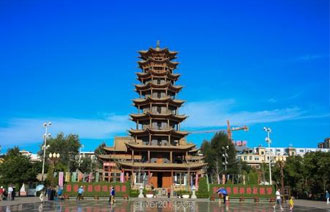Hanging (Xuankong) Monastery
 Being the most outstanding Buddhist temples in China, Hanging (Xuankong) Monastery is situated at the foot of the Hengshan Mountain, 75 kilometers southeast of Datong. First built in the late Northern Wei dynasty in the 6th century and renovated three or four times since, the serried buildings look as though they are supported by a dozen or so slim wooden posts no more substantial than chopsticks. Huge rocks loomed overhead, apparently liable to fall at any moment. The fragile path was strung out along the face of the cliff. There were two reasons to construct the Hanging Temple here.
Being the most outstanding Buddhist temples in China, Hanging (Xuankong) Monastery is situated at the foot of the Hengshan Mountain, 75 kilometers southeast of Datong. First built in the late Northern Wei dynasty in the 6th century and renovated three or four times since, the serried buildings look as though they are supported by a dozen or so slim wooden posts no more substantial than chopsticks. Huge rocks loomed overhead, apparently liable to fall at any moment. The fragile path was strung out along the face of the cliff. There were two reasons to construct the Hanging Temple here.
Yungang Grottoes
 Located at the southern foot of Wuzhou Mountain some 16 kilometers west of Datong City, Shanxi Province, contain China’s largest and earliest stone sculpture, Yungang Grottoes were built against the mountain and extend about 1 kilometer (0.62 miles) from east to west. These are known as one of the three major Grottoes in China. The construction of the caves was started under the auspices of the noted monk Tan Yao in 453 and took 50 years to complete. Some 40,000 people, including the Buddhists from what is present Sri Lanka, contributed to the huge project. The art of the Yungang Grottos may be considered a manifestation of a process of blending of cultures and religions
Located at the southern foot of Wuzhou Mountain some 16 kilometers west of Datong City, Shanxi Province, contain China’s largest and earliest stone sculpture, Yungang Grottoes were built against the mountain and extend about 1 kilometer (0.62 miles) from east to west. These are known as one of the three major Grottoes in China. The construction of the caves was started under the auspices of the noted monk Tan Yao in 453 and took 50 years to complete. Some 40,000 people, including the Buddhists from what is present Sri Lanka, contributed to the huge project. The art of the Yungang Grottos may be considered a manifestation of a process of blending of cultures and religions
The Nine Dragon Screen
 Located at the center of the city of Datong, by far the most magnificent Screens in China, Nine Dragon Screen was originally part of the gate to the mansion of Prince Hongwu, the 13th son of the first emperor of the Ming Dynasty (1368-1644 AD). As a symbol of the ancient emperors of China, the dragons were depicted fighting and frolicking in the clouds above the blue sea. According to Chinese superstition, ghosts and devils can only travel in straight lines, so these magnificent screens were placed before residency gates in order to keep them off. The Nine Dragon Screen was built more than six hundred years ago, and is not only larger than the nine-dragon screen in Beijing's Beihai Park, but three hundred years older.
Located at the center of the city of Datong, by far the most magnificent Screens in China, Nine Dragon Screen was originally part of the gate to the mansion of Prince Hongwu, the 13th son of the first emperor of the Ming Dynasty (1368-1644 AD). As a symbol of the ancient emperors of China, the dragons were depicted fighting and frolicking in the clouds above the blue sea. According to Chinese superstition, ghosts and devils can only travel in straight lines, so these magnificent screens were placed before residency gates in order to keep them off. The Nine Dragon Screen was built more than six hundred years ago, and is not only larger than the nine-dragon screen in Beijing's Beihai Park, but three hundred years older.
Wooden Pagoda in Yingxian County
 The real name of the pagoda, located in Fogong (Buddha's Palace) Temple in the northwestern corner of the county town of Yingxian, is Sakyamuni Pagoda. Since it was built completely of timber, it has been known popularly as the Wooden Pagoda of Yingxian County. It is the oldest wooden structure extant today in China, and also the tallest among ancient wooden buildings of the world. The pagoda was constructed in 1056 during the Liao Dynasty. The Wooden Pagoda stands nearly 70 meters tall is 30-meters in diameter and weighs over 300 tons. Made up of at least 3,500 cubic meters of wood, the pagoda is octagonal in shape and contains nine floors, with four built-in stories not apparent from the outside.
The real name of the pagoda, located in Fogong (Buddha's Palace) Temple in the northwestern corner of the county town of Yingxian, is Sakyamuni Pagoda. Since it was built completely of timber, it has been known popularly as the Wooden Pagoda of Yingxian County. It is the oldest wooden structure extant today in China, and also the tallest among ancient wooden buildings of the world. The pagoda was constructed in 1056 during the Liao Dynasty. The Wooden Pagoda stands nearly 70 meters tall is 30-meters in diameter and weighs over 300 tons. Made up of at least 3,500 cubic meters of wood, the pagoda is octagonal in shape and contains nine floors, with four built-in stories not apparent from the outside.
| Datong Attractions List | |

